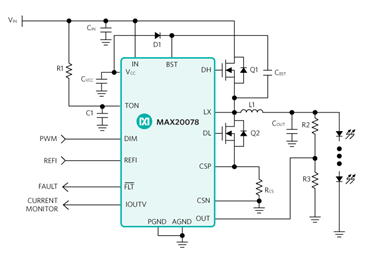With LED lighting technology comes more creative headlamp designs, as well as brighter, smarter, and more energy-efficient automotive lights. Last year, the Insurance Institute for Highway Safety (IIHS) issued its first headlight ratings, which generally revealed the need for vast improvements. “With about half of traffic deaths occurring either in the dark or in dawn or dusk conditions, improved headlights have the potential to bring about substantial reductions in fatalities,” noted the IIHS in a news release about its headlight ratings. By 2019, both the IIHS and the National Highway Traffic Safety Administration (NHTSA) are expected to begin considering headlamp performance in their overall new car ratings.
While not yet approved for cars in the U.S., LED matrix headlights present even more options since they can actively shade and illuminate sections of the road. For example, the combination of matrix lighting, smarter software, and sensitive infrared cameras can spotlight speed-limit signs without flooding the scene with bright light or illuminate pedestrians while blacking out their faces.Indeed, headlamps have become important elements of automotive safety and advanced driver assistance systems (ADAS).
When it comes to automotive LED lighting design, there are various design challenges you should address to prevent these issues from affecting lighting performance. In high-brightness (HB) LEDs, for instance, inherently high switching frequency can result in electromagnetic interference (EMI) that degrades or inhibits circuit performance. For matrix lighting, LED drivers and controllers are challenged when switching LEDs at high speeds, which can cause overshoots and undershoots in current. EMI is especially hard to resolve because of the nature of matrix lighting applications—there are a lot of LED lights in a densely concentrated area. As a result, vehicle manufacturers spend a lot of time, money, and effort trying to reduce EMI by experimenting with different layouts and filtering methods. If unresolved, EMI can affect lighting performance as well as other automotive sub-systems, including the radio and anything with a high-speed link. Plus, automotive regulatory specifications do call for EMI to be maintained at specific levels. It is, however, ironic that some of the techniques for minimizing EMI can actually induce flickering.
Maxim has developed an automotive-grade controller—the MAX20078 synchronous buck, high-brightness LED controller—that addresses the design challenges I’ve highlighted, driving greater performance for automotive lighting systems. See Figure 1 for a block diagram of the LED controller.

Fast Response Time with Low EMI
The MAX20078 is the market’s only LED controllerable to provide both fast response time and low EMI for exterior LED lighting and improved safety applications. The controller works well for matrix lighting designs, enabling designers to achieve high performance and fast time to market while easing the design process.
It is challenging to switch LEDs at fast speed, but, at the same time, high speed is critical in order to deliver high performance for advanced lighting applications. While many parts on the market aren’t able to handle such switching speeds, this is a capability where the MAX20078 excels. The LED controller also:
- Eliminates the trade-off between low EMI and fast LED switching speeds, providingone-clock-cycle response time and nearly fixed frequency to more easily predict and reduce EMI
- Shorts/opens LEDs while maintaining current regulation, an ideal backdrop for matrix lighting applications
- Eliminates compensation components
- Provides a wide dimming ratio
- Includes integrated fault protection and monitoring circuitry
Given these functions, designs using the LED controller are equipped to deliver brighter, more constant lighting with better efficiency and directional control. Hysteretic bucks are another option to enable this level of performance; however, these parts have variable frequency that drives more complexity in the designs. With hysteretic parts, the more you switch the LEDs in and out, the more the frequency will fluctuate, causing EMI challenges that will add to the bill of materials (BOM) cost. The MAX20078 eliminates the need for compensation components, integrated fault protections, and monitoring circuitry, thus simplifying the design. A MAX20078 evaluation kit is available for evaluating the component for applications such as front and rear lighting, high beams, low beams, daytime running lamps, heads-up display, and turn signals. Since lighting is increasingly important for safety, it’s always good to see continued advancements in LED lighting technology.
Author







